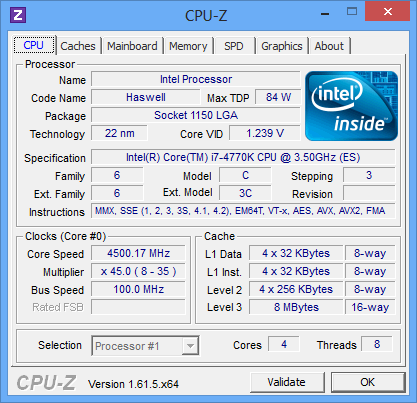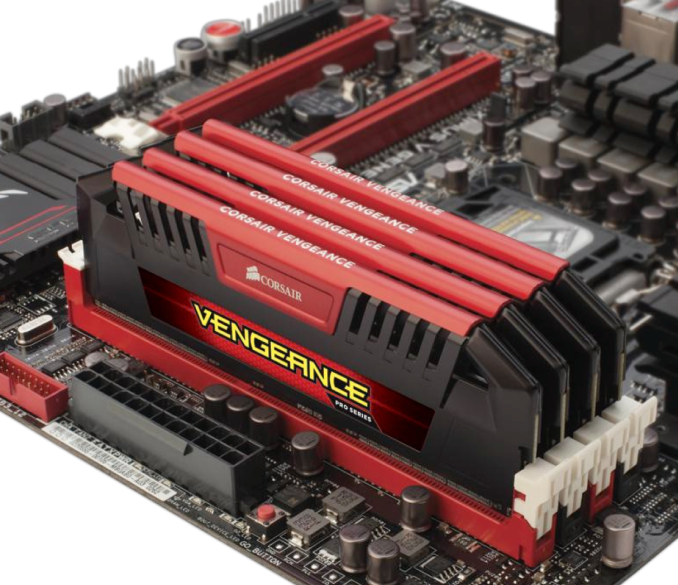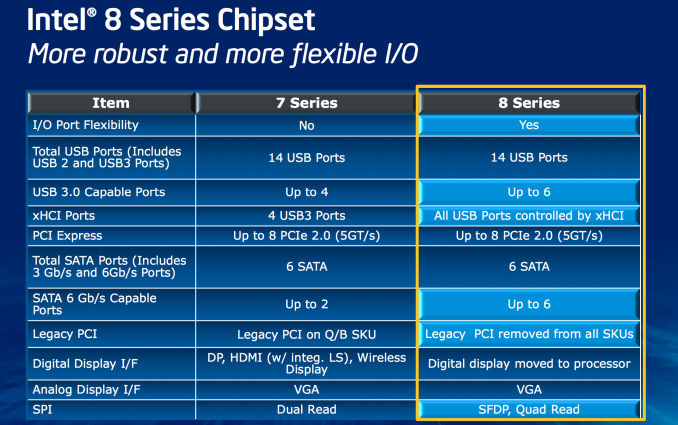The Haswell Review: Intel Core i7-4770K & i5-4670K Tested
by Anand Lal Shimpi on June 1, 2013 10:00 AM ESTMemory
Haswell got an updated memory controller that’s supposed to do a great job of running at very high frequencies. Corsair was kind enough to send over some of its Vengeance Pro memory with factory DDR3-2400 XMP profiles. I have to say, the experience was quite possibly the simplest memory overclocking I’ve ever encountered. Ivy Bridge was pretty decent at higher speeds, but Haswell is a different beast entirely.
Although I used DDR3-2400 for most of my testing, Corsair’s Vengeance Pro line is available in frequencies rated all the way up to 2933MHz.
Platform
Haswell features a new socket (LGA-1150). Fundamental changes to power delivery made it impossible to maintain backwards compatibility with existing LGA-1155 sockets. Alongside the new socket comes Intel’s new 8-series chipsets.
At a high level the 8-series chipsets bring support for up to six SATA 6Gbps and USB 3.0. It’s taken Intel far too long to move beyond two 6Gbps SATA ports, so this is a welcome change. With 8-series Intel also finally got rid of legacy PCI support.
Overclocking
Despite most of the voltage regulation being moved on-package, motherboards still expose all of the same voltage controls that you’re used to from previous platforms. Haswell’s FIVR does increase the thermal footprint of the chip itself, which is why TDPs went up from 77W to 84W at the high-end for LGA-1150 SKUs. Combine higher temperatures under the heatspreader with a more mobile focused chip design, and overclocking is going to depend on yield and luck of the draw more than it has in the past.
Haswell doesn’t change the overclocking limits put in place with Sandy Bridge. All CPUs are frequency locked, however K-series parts ship fully unlocked. A new addition is the ability to adjust BCLK to one of three pre-defined straps (100/125/167MHz). The BCLK adjustment gives you a little more flexibility when overclocking, but you still need a K-SKU to take advantage of the options.


In terms of overclocking success on standard air cooling you should expect anywhere from 4.3GHz - 4.7GHz at somewhere in the 1.2 - 1.35V range. At the higher end of that spectrum you need to be sure to invest in a good cooler as you’re more likely to bump into thermal limits if you’re running on stable settings.

















210 Comments
View All Comments
Nacho - Saturday, June 1, 2013 - link
Maybe it's time to upgrade my C2D E4300? :Pkrumme - Saturday, June 1, 2013 - link
Absolutely, go get a good ssd and this processor or IB, if its for desktop.Oscarcharliezulu - Monday, June 3, 2013 - link
Do it.Boissez - Saturday, June 1, 2013 - link
So my 2½ year old 2600K ($317) performs about the same as todays 4560K ($242). Color me underwhelmed.Meanwhile in mobileland we've went from 1 Ghz Tegra 2 to 2 Ghz Snapdragon S600 within the same timespan.
tential - Saturday, June 1, 2013 - link
Because for 99.9% of the population what's out there today is more than fast enough. Hell, the Core2Duo Conroe/Penryn processors are fast enough for most people today. I'm still using one in fact.On the mobile side however, we have tons of applications that could use more power. My galaxy S3 takes a little to load up some games, and while the data may have been downloaded to the phone through wifi, it still isn't on my screen yet.
I think it's pretty obvious why you see mobile land having to progress so fast while desktop processors are focusing on power consumption as the AVERAGE consumer (not people who are techies) would prefer smaller PCs and pushing more power efficient processors into smaller and smaller things like the intel NUC is what the consumer desires.
In short:
Your desires are the 1%. The 99% are being catered to.
klmccaughey - Monday, June 3, 2013 - link
@tential: Your last statement, maybe it should read "OUR desires are the 1%"? ;) I bet we would all be clapping right now if the 4770k was a big upgrade. Well, most of us, I think?jeffkibuule - Saturday, June 1, 2013 - link
Mobile is having the same performance renaissance that desktop chips had from 2004-2006 when we went from a hot, bloated Pentium 4 to a cool, efficient Core 2 Duo. And certainly we've had performance gains since then, but eventually the gains won't come so easily. You can start to see that a bit now with how the Exynos 5250 in the Nexus 10 is thermally throttled to 4W such that CPU and GPU can't be both running full tilt at the same time.Homeles - Saturday, June 1, 2013 - link
You're disappointed because your understanding of physics and Moore's Law is poorly developed. The scenario you've provided is a blatant false equivalency.According to your desperate desires, the roughly 4GHz processors that launched with Sandy Bridge should be running at twice the clock speed today.
When you understand that leakage power grows exponentially as transistor geometries shrink, and that power consumption raises exponentially as clock speed rises, you will realize that even the 10% gains that Haswell makes here are a big deal.
Dal Makhani - Saturday, June 1, 2013 - link
Homeles, I really appreciate your well said comment, im taking a business degree with an accounting major, but ive always loved building PC's as a hobby. When some of my computer science/engineer friends try to show me the stuff they are learning, i am baffled as its not my area of expertise. I can only imagine how challenging it is to combat the shrinking processes and make performance gains as you said. I have deep respect for Intel and AMD, always trying to utilize their research and engineers to try and make any gains for society. These forum people are just so ignorant sometimes and it baffles me.chizow - Saturday, June 1, 2013 - link
Hey, similar path as me. :) Don't worry about lack of understanding now, stick to it, keep reading great technical sites like AT, keep an open mind, and you'll get a really good grip on the industry, especially if you are an actual user/enthusiast of the products.